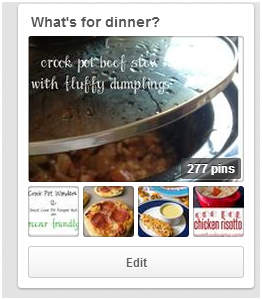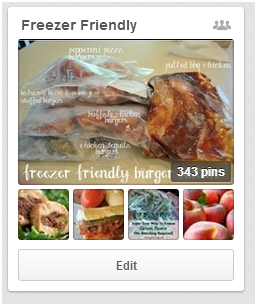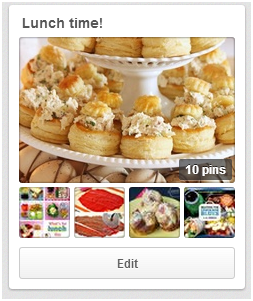Here are the printables I use & how I use them:

(Click here for a PDF version of the printables!)
These work for me for a variety of reasons:
*I don’t like to spend time grocery shopping every week, so by meal planning and making my list accordingly, I can spread my shopping trips out to every 2-3 weeks.
*Not taking so many trips to the grocery store saves money!
*By knowing exactly what I’m going to cook, I can plan my list accordingly so there’s no playing the game: "what the heck am I going to make for dinner with these ingredients." (Because sometimes it can be like an at home version of “Chopped” and that’s no good…you’ve seen what’s in those baskets!)
*Having my shopping list by section really helps me breeze in and out of the store and brings my “shoot-I-forgot-to-get-this" down to a minimum.
*I also can see at a glance which of my meals (or parts of) I can prep for the freezer ahead of time and I usually can get most of that done during my daughter’s nap time.
*I ALWAYS keep my menu list easily accessible. I know what meals I can make with what I have…and I can give my husband options on what he’d like for dinner so it’s a win win.
*By using the shopping list in sections I can easily see at a glance what the bulk of my purchase is…am I buying too many canned goods? Not enough protein to get us through a few weeks? Have in included enough fresh produce? (I will make spot trips to the store for fresh produce!)
Let’s get started using these bad boys!
1. First, I sit down with a cup of coffee (or wine…) and scour my pin boards with my sheets at my side. Here are some screen shots and links to my boards…
What's for dinner? Freezer Friendly
Lunch Time! Sunday Funday
2. I’ll add recipes to my menu as I find meals that I know my family will enjoy. I also enjoy finding a variety of meals so I’m not getting into a rut of making the same thing.
3. I also make note on my menu if a recipe will make two meals (x2) or if it’s freezer friendly (F) so I can check that at a glance.
4. Once I have my meals planned out, it’s on to the shopping list. I actually print the shopping list about a week before I go shopping so I can add extras to it as I run out (baking soda, toilet paper, etc. Things that we need, but might not be specifically in my meals). I sit down with each recipe (or think about it in my head if it’s one I’ve made over and over) and the ingredients I don’t have in the pantry or fridge get added to the list.
(Don’t mind my sloppy handwriting or atrocious spelling.)
On my list I’ll make myself notes like what I’m using the ingredient for or if it’s on sale at the store. So once I have all of this, I’ll head out to the store and shop! If I’m really feeling ambitious, I’ll print out a calendar and write down our dinners on it so I have a blueprint of the next few weeks. But more than likely that changes anyway.
HEALTHY MEAL PLANNING:
Here are some tips from our Registered Dietitian, Meg Loc on planning healthy freezer meals for your family:
I’ve broken it down by category for freezer friendly dishes. Once you know key ingredients to steer clear of (cream of anything soup, for example) you’ll get the hang of it. Then you can pick your favorite recipes and create a game plan to stock your freezer.
Chili, Soup, and Stew:
· Lighten up chili by using lean meats and poultry like 90% or more lean ground beef, ground chicken or turkey breast. You can even make a vegetarian chili by using a mixture of your favorite canned beans. Chili freezes well and is a hearty meal on its own, so pair with baked tortilla chips (Try Utz baked tortilla chips), salsa, and guacamole – ditch the cheese and sour cream, you won’t miss it.
· Broth based soups are a freezer rock star. Prepare a large pot of soup that contains plenty of veggies. Simply defrost and pair with a healthy salad or sandwich on whole grain bread for a healthy and filling dinner. Try these classics: beef and barley, chicken noodle, lentil, or minestrone.
· Stews freeze well and are versatile. You can prepare them and freeze or prep a slow cooker kit to freeze and cook later. No matter what stew you’re making, be sure to add plenty of vegetables, use lean cuts of beef, and opt for low-sodium broth.
Casseroles and Other Entrées:
- Most casseroles can be modified to cut calories by halving the amount of cheese, using milk in place of cream, and soft tub margarine instead of butter. Steer clear of recipes that call for “cream of…” soups for thickening and opt for ones that include plenty of veggies like Mexican lasagna bake and polenta ragu bake.
· Make a lighter version of lasagna with ground chicken or turkey breast. Add chopped mushrooms to the meat mixture and chopped frozen spinach (thawed) to the part-skim ricotta cheese mixture. Use whole wheat lasagna noodles and start layering!
· Sometimes, sides can be easier to whip up during a weekday, but the main dish may slow you down. Make ahead main dishes like meatballs (90% or more lean ground beef), grilled chicken, or even marinated fish. Make a main dish salad with grilled chicken or steam veggies to pair with your fish!
Take Some Help from the Supermarket
Sometimes, all you need is a little help from the freezer section of your local supermarket. Load up on microwave ready sides and vegetables.
· Stock up on steam-in-bag frozen veggies and frozen edamame.
· For healthier frozen starchy sides try some of my favorites: Birds Eye baby potato or brown and wild rice blend, Alexia Foods potato sauté varieties, and Village Harvest frozen whole grain varieties (quinoa, barley, farro, brown, red, and wild rice).
*Don’t forget to keep a stocked pantry and refrigerator for balanced meals. Here’s what I always have on hand:
· Bagged salads and fresh vegetables (whatever is in season and on sale!)
· Microwaveable brown rice – in different varieties – Jasmine, basmati.
· Sweet and regular potatoes
· Quinoa
Freezer Safe
Keep these points in mind for food safety:
- Divide cooked foods into smaller portions in shallow containers. Soups and stews should be put into portions that are two to three inches deep. Stir them while cooling to speed the release of heat.
- Place meals directly in the refrigerator, then transfer to the freezer once they're cold.
- Defrost meals in the refrigerator or microwave, never on the counter.
- Reheat all frozen meals to 165ºF and soups and sauces should be brought to a boil.
- Frozen meals should be used within 2 months.








.jpeg)
.jpeg)
.jpeg)
No comments:
Post a Comment